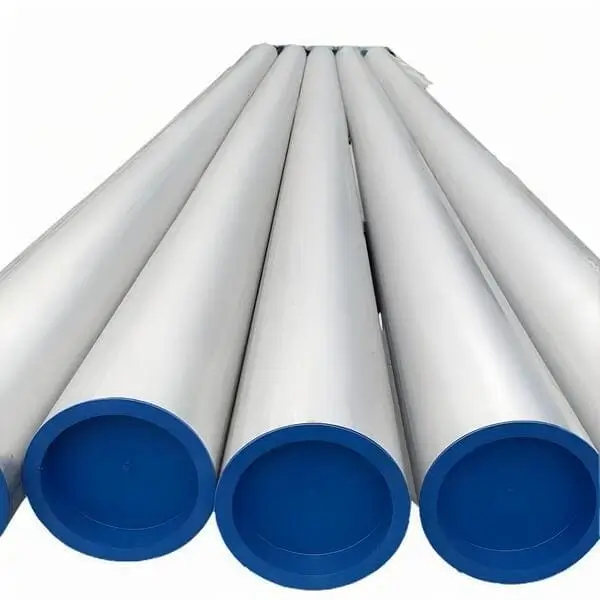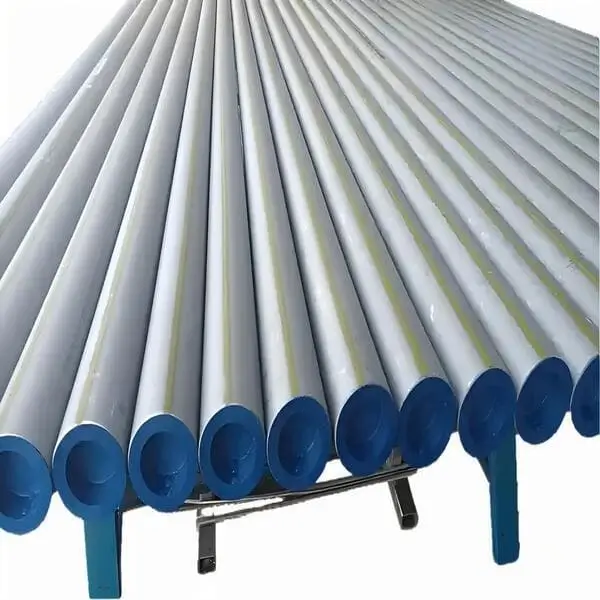How to Maintain Electropolishing Solutions for Stainless Steel Pipe and Prevent Residual Acid Corrosion
How to Maintain Electropolishing Solution for Stainless Steel Pipe and Prevent Residual Acid Corrosion:
- Solution Maintenance: Regularly monitor specific gravity (target: 1.65–1.75) and metal ion content (Fe <60 g/L, Cr³⁺ <40 g/L). Adjust by evaporating excess water or replenishing acids (H₃PO₄/H₂SO₄). For aging solutions, replace 80% with fresh mix.
- Process Control: Maintain cathode-to-anode ratio at 1:2, electrode spacing at 100–300 mm, and temperature at 55–75°C. Optimize current density (10–50 mA/cm²) for uniform polishing.
- Contamination Prevention: Eliminate chlorides (<50 ppm) via electrolysis. Clean cathode deposits weekly to ensure conductivity.
- Post-Treatment: Neutralize residual acid with Na₂CO₃ (30 g/L) and dry thoroughly to avoid corrosion.
1. Introduction
Electropolishing is a critical electrochemical process used to enhance the surface quality and corrosion resistance of stainless steel pipes and tubes, including duplex stainless steel pipes (with austenitic-ferritic microstructure and density between 1–2%). This technique removes surface impurities, reduces micro-roughness, and forms a passive oxide layer. However, maintaining the electropolishing solution and preventing residual acid corrosion require strict adherence to process parameters, solution chemistry management, and post-treatment protocols. This guide provides a comprehensive, step-by-step approach to optimizing electropolishing for stainless steel components.
2. Pre-Treatment Procedures
How to Maintain Electropolishing Solution for Stainless Steel Pipe and Prevent Residual Acid Corrosion:
Proper pre-treatment ensures contaminants like oils, grease, or oxides do not compromise the polishing solution.
Key Steps:
- Degreasing:
- Use alkaline cleaners (pH 10–12) at 60–70°C for 10–15 minutes.
- For duplex stainless steel pipes, avoid chloride-containing degreasers to prevent pitting.
- Mechanical Cleaning:
- Scrub surfaces with non-metallic brushes and abrasive detergent powder.
- Rinse thoroughly with deionized water (conductivity <10 µS/cm).
- Drying:
- Blow-dry using oil-free compressed air to eliminate residual moisture.
Critical Pre-Treatment Metrics:
| Parameter | Requirement |
|---|---|
| Residual oil/grease | <0.1 mg/cm² |
| Surface roughness (Ra) | <0.8 µm (pre-polish) |
| Drying time | ≤5 minutes |
3. How to Maintain Electropolishing Solutions for Stainless Steel Pipe
How to Maintain Electropolishing Solution for Stainless Steel Pipe and Prevent Residual Acid Corrosion:
3.1 Solution Composition
A typical electropolishing solution for stainless steel pipes contains:
Phosphoric acid (H₃PO₄): 60–70% (v/v)
Sulfuric acid (H₂SO₄): 15–20% (v/v)
Chromium trioxide (CrO₃): 5–10% (w/v) (for Cr⁶⁺ generation)
Note: For duplex stainless steel pipes, reduce sulfuric acid to 10–15% to avoid over-etching ferritic phases.
3.2 Monitoring and Adjusting Key Parameters
Regular monitoring prevents solution degradation and ensures consistent results.
Parameter | Target Range | Adjustment Method |
|---|---|---|
Specific Gravity | 1.65–1.75 (varies by formula) | – Too low: Evaporate water at >80°C; replenish H₃PO₄/H₂SO₄. – Too high: Add deionized water. |
Fe Content | <60 g/L | Replace 80% of aged solution with fresh mix if exceeded. |
Cr³⁺/Cr⁶⁺ Ratio | 3:7 (Cr⁶⁺³⁺) | – Excess Cr⁶⁺ (yellow): Add gelatin/glycerin. – Excess Cr³⁺ (green): Add CrO₃ or oxidize via electrolysis. |
Temperature | 55–75°C | Use titanium chillers to maintain ±2°C stability. |
Solution Regeneration Methods:
Dilution-Precipitation:
Dilute with 20% water → Settle for 24h → Remove sludge → Re-concentrate by evaporation.
Energy cost: ~15 kWh/m³.
Partial Replacement:
Retain 20% old solution + 80% fresh solution → Immediate reuse.
4. Process Optimization
How to Maintain Electropolishing Solution for Stainless Steel Pipe and Prevent Residual Acid Corrosion:
4.1 Electrode Configuration
| Parameter | Requirement | Impact of Deviation |
|---|---|---|
| Cathode-to-Anode Ratio | 1:2 (area) | Prevents Cr³⁺ accumulation and solution aging. |
| Electrode Distance | 100–300 mm | – Too close: Short-circuiting. – Too far: Uneven polishing, energy waste. |
| Conformal Cathodes | Mandatory for complex pipes | Ensures uniform current distribution in bends or large diameters. |
4.2 Current and Voltage Settings
- Anode Current Density: 10–50 mA/cm² (optimize empirically).
- Voltage: 8–20 V (depends on pipe diameter and solution conductivity).
Example for Duplex Stainless Steel:
| Pipe Diameter (mm) | Current Density (mA/cm²) | Polishing Time (min) | Material Removal (mm) |
|---|---|---|---|
| 10–50 | 20–30 | 10–15 | 0.01–0.02 |
| 50–200 | 30–40 | 15–20 | 0.02–0.03 |
4.3 Temperature Control
- Use plate heat exchangers or industrial chillers for continuous cooling.
- Impact of Temperature:
- >75°C: Accelerates Cr⁶⁺→Cr³⁺, causing pitting.
- <55°C: Increases viscosity, reduces material removal rate by 30–50%.

5. Chloride Contamination Management
How to Maintain Electropolishing Solution for Stainless Steel Pipe and Prevent Residual Acid Corrosion:
Chlorides (>50 ppm) disrupt the passive layer, leading to pitting.
| Source | Mitigation Strategy |
|---|---|
| Residual HCl from pickling | Rinse 3x with deionized water (conductivity <5 µS/cm). |
| Low-purity acids | Use reagent-grade H₃PO₄/H₂SO₄ (≥98% purity). |
Dechlorination Method:
- Electrolyze solution at 50 mA/cm² for 2–4 hours to oxidize Cl⁻ → Cl₂ gas.
6. Post-Polishing Treatments
How to Maintain Electropolishing Solution for Stainless Steel Pipe and Prevent Residual Acid Corrosion:
6.1 Rinsing and Neutralization
Rinse Sequence:
40°C warm water (2 min) → Cold water (1 min) → Neutralization in 30 g/L Na₂CO₃ (5 min).
Drying:
Blow-dry with filtered air (dew point < -40°C).
6.2 Passivation (Optional)
For enhanced corrosion resistance, immerse pipes in 20% HNO₃ at 50°C for 30 minutes.
Post-Treatment Metrics:
Parameter | Target Value |
|---|---|
Surface roughness (Ra) | ≤0.2 µm |
Residual acid (pH) | 6–8 (after neutralization) |
7. Troubleshooting Common Issues
How to Maintain Electropolishing Solution for Stainless Steel Pipe and Prevent Residual Acid Corrosion:
| Issue | Root Cause | Solution |
|---|---|---|
| Dull Surface | Low current density | Increase to 30–50 mA/cm². |
| Streaks/Pitting | Cl⁻ contamination or bubbles | Dechlorinate; implement anode agitation. |
| Uneven Polishing | Incorrect cathode placement | Use conformal cathodes for complex shapes. |
| Rapid Solution Aging | High Fe/Ni/Cr³⁺ | Replace 80% of solution; clean cathodes. |
8. Case Study: Electropolishing Duplex Stainless Steel Pipes
How to Maintain Electropolishing Solution for Stainless Steel Pipe and Prevent Residual Acid Corrosion:
A manufacturer of duplex stainless steel pipes (density: 1.5%) faced pitting and inconsistent finishes.
Solution:
- Adjusted solution to H₃PO₄ (65%) + H₂SO₄ (12%) + CrO₃ (8%).
- Implemented conformal cathodes for 150 mm diameter pipes.
- Reduced Cl⁻ from 75 ppm to <10 ppm via electrolysis.
Results:
- Surface roughness improved from 0.7 µm to 0.15 µm.
- Passivation layer stability increased by 40%.
9. Best Practices for Long-Term Success
how to maintain electropolishing solutions for stainless steel pipe and prevent residual acid corrosion
- Weekly Analysis: Test Fe, Cr³⁺, and Cl⁻ levels.
- Anode Agitation: Use 5–10 Hz reciprocating motion to eliminate bubbles.
- Training: Certify operators in ASTM B912 and ISO 15730 standards.
10. Conclusion
Effective electropolishing of stainless steel pipes hinges on meticulous solution maintenance, precise process control, and rigorous post-treatment. By adhering to the guidelines above—particularly for duplex stainless steel with density between 1–2%—manufacturers can achieve superior surface finishes, extend component lifespan, and eliminate acid corrosion risks. Regular audits and investments in high-purity chemicals further ensure process reliability.


